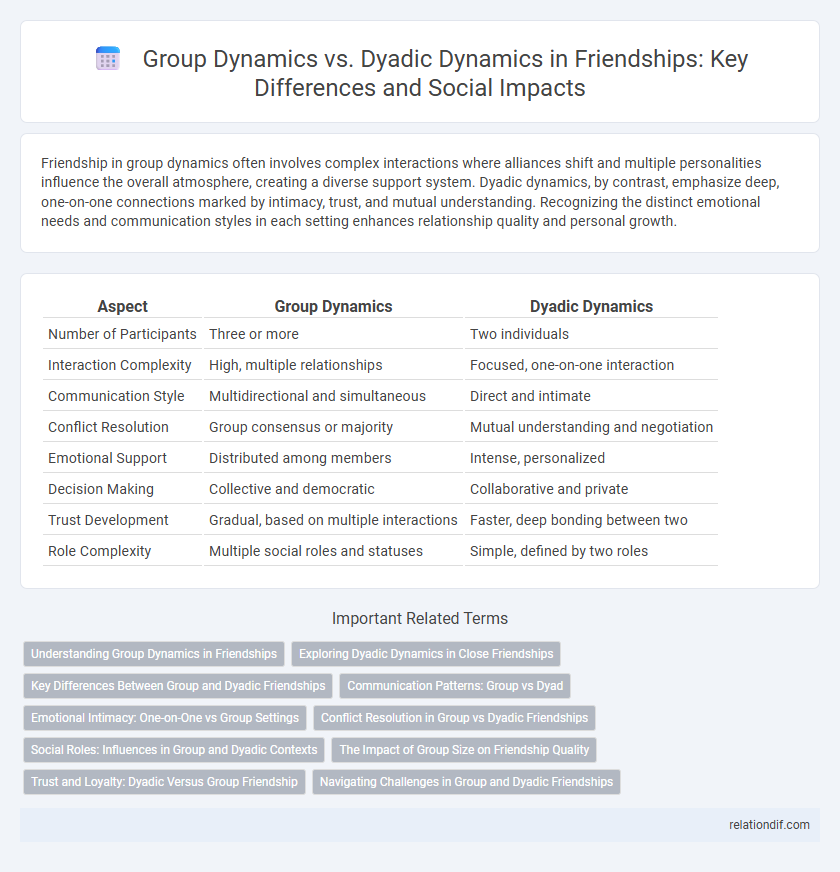Friendship in group dynamics often involves complex interactions where alliances shift and multiple personalities influence the overall atmosphere, creating a diverse support system. Dyadic dynamics, by contrast, emphasize deep, one-on-one connections marked by intimacy, trust, and mutual understanding. Recognizing the distinct emotional needs and communication styles in each setting enhances relationship quality and personal growth.
Table of Comparison
| Aspect | Group Dynamics | Dyadic Dynamics |
|---|---|---|
| Number of Participants | Three or more | Two individuals |
| Interaction Complexity | High, multiple relationships | Focused, one-on-one interaction |
| Communication Style | Multidirectional and simultaneous | Direct and intimate |
| Conflict Resolution | Group consensus or majority | Mutual understanding and negotiation |
| Emotional Support | Distributed among members | Intense, personalized |
| Decision Making | Collective and democratic | Collaborative and private |
| Trust Development | Gradual, based on multiple interactions | Faster, deep bonding between two |
| Role Complexity | Multiple social roles and statuses | Simple, defined by two roles |
Understanding Group Dynamics in Friendships
Understanding group dynamics in friendships involves analyzing how individual behaviors, roles, and communication patterns influence the overall cohesion and conflict within the group. Group dynamics include factors such as social norms, leadership structures, and collective decision-making processes that differ significantly from dyadic dynamics, which focus solely on interactions between two individuals. These dynamics impact the stability and satisfaction of friendships by shaping inclusion, influence, and emotional support among members.
Exploring Dyadic Dynamics in Close Friendships
Dyadic dynamics in close friendships center on one-on-one interactions that foster deeper emotional intimacy and personalized support, contrasting with group dynamics where attention disperses among multiple members. These individualized exchanges enable friends to navigate conflicts with tailored communication styles and create unique shared experiences that strengthen trust. Research highlights that dyadic interactions contribute significantly to emotional well-being by providing a safe space for vulnerability and mutual understanding.
Key Differences Between Group and Dyadic Friendships
Group friendships involve multiple individuals interacting simultaneously, fostering diverse perspectives, shared responsibilities, and complex social hierarchies. Dyadic friendships center on a one-on-one bond characterized by deeper emotional intimacy, personalized communication, and focused mutual support. The key difference lies in the complexity and intimacy, where group dynamics emphasize collective interactions and dyadic dynamics prioritize exclusive, individualized connections.
Communication Patterns: Group vs Dyad
Group communication patterns involve complex interactions where multiple voices and perspectives influence the flow, often requiring turn-taking and active management to maintain cohesion. Dyadic communication in friendships tends to be more intimate and direct, allowing for deeper emotional exchange and immediate feedback between two individuals. Understanding these differences helps optimize relationship quality by tailoring communication strategies to the social context.
Emotional Intimacy: One-on-One vs Group Settings
Emotional intimacy in dyadic friendships nurtures deep trust and vulnerability through focused, personalized interactions that often lead to stronger support systems. In group dynamics, emotional intimacy tends to be more diffuse, influenced by multiple relational ties and social roles that can dilute individual expressions of trust. While one-on-one settings allow for clearer emotional exchanges, group contexts encourage shared experiences that build collective empathy and social cohesion.
Conflict Resolution in Group vs Dyadic Friendships
Conflict resolution in group friendships often involves negotiating multiple perspectives and balancing competing interests, requiring collaborative strategies and communication skills to reach consensus. In dyadic friendships, conflict resolution tends to be more direct and personalized, with focus on mutual understanding and emotional attunement between the two individuals. Group dynamics introduce complexity through social roles and alliances, while dyadic dynamics allow for deeper intimacy and tailored conflict management.
Social Roles: Influences in Group and Dyadic Contexts
Social roles significantly shape interactions within both group and dyadic dynamics by dictating behavioral expectations and responsibilities that influence communication patterns and decision-making processes. In group contexts, role differentiation such as leader, mediator, or challenger often emerges to manage complexity and maintain cohesion, while dyadic interactions rely more on reciprocal and flexible role exchanges that adapt to individual needs and relationship history. Understanding these social roles enhances insight into how influence is distributed and conflicts are resolved in friendships across varying social structures.
The Impact of Group Size on Friendship Quality
Group size significantly influences friendship quality by altering interaction patterns and emotional intimacy. In dyadic dynamics, friendships allow for deeper, more personalized connections, while larger group settings foster broader social networks but often reduce individual closeness. Research indicates that as group size increases, the quality of friendship bonds tends to decrease due to diminished one-on-one attention and increased social complexity.
Trust and Loyalty: Dyadic Versus Group Friendship
Dyadic friendships often foster deeper trust and stronger loyalty through one-on-one interactions that allow for personalized support and vulnerability. In contrast, group dynamics prioritize inclusivity and shared experiences, which can dilute individual trust but enhance a sense of collective loyalty. Trust in dyadic relationships tends to be more intense and emotionally grounded, while group friendships rely on broader social cohesion and mutual respect among members.
Navigating Challenges in Group and Dyadic Friendships
Navigating challenges in group friendships requires managing multiple relationships with differing communication styles, conflict resolutions, and individual needs, often necessitating compromise and role negotiation. In dyadic friendships, challenges center on deeper personal conflicts and direct communication, where trust and empathy are crucial to resolving misunderstandings and maintaining intimacy. Understanding the unique dynamics of group versus dyadic friendships helps effectively address conflicts, fostering stronger, more resilient social bonds.
Group dynamics vs Dyadic dynamics Infographic

 relationdif.com
relationdif.com